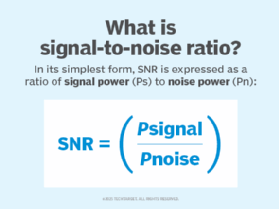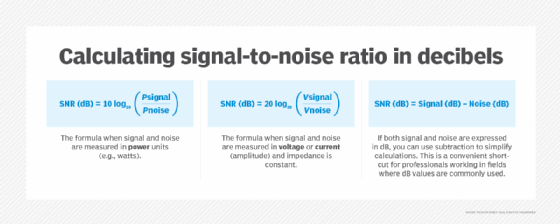What is signal-to-noise ratio and how is it measured?
In analog and digital communications, a signal-to-noise ratio -- often written S/N or SNR -- is a measure of the strength of a desired signal relative to background noise (unwanted interference). In this context, the term signal describes meaningful information, and noise refers to any disturbance that degrades the quality of the desired signal.
SNRs are used in science and engineering to quantify signal clarity. SNR can be represented as a raw ratio (e.g., 100:1), but in technical specifications, the ratio is more commonly seen as a single numeric value that's expressed in decibels (dB). This approach takes advantage of the logarithmic scale and makes it easier to compare, calculate and interpret signal quality across different systems.
Because almost all real-world systems operate in environments where noise is present, SNR is often used as a key performance indicator (KPI) to evaluate system quality and diagnose signal transmission problems. The ratio is also used as a benchmark for assessing improvements designed to compensate for signal attenuation.
Why signal-to-noise ratio is important
Signal-to-noise ratio is an important KPI because it quantifies how accurately a desired signal can be distinguished from background noise. A higher SNR means the signal is clearer, while a lower SNR implies that noise levels are comparable to (or greater than) the signal.
If the noise level is significantly higher than the strength of the desired signal, it can make meaningful information harder to detect, interpret and/or transmit reliably. On a practical level, excessive noise can disrupt data transfers for text files, audio files, graphics, telemetry applications, and audio or video streams:
- In analog signals, noise can directly corrupt the waveform, and this can lead to signal distortion and/or loss of information.
- In digital systems, excessive noise can result in high error rates, frequent retransmissions or total communication failure.
- In media applications, a high percentage of noise can distort audio, blur images and make it hard to discern details.
- In precision measurement systems, a negative SNR can mask critical data and reduce the accuracy of results.
- In communications systems, SNR can also affect channel capacity. Channel capacity refers to the maximum amount of data that can be transmitted reliably over that channel at any given time.
What is the formula for SNR?
Signal-to-noise is a ratio, and ratios use division to compare two quantities. In the context of SNR, the ratio uses division to compare the strength of a desired signal to the level of background noise.

The ratio of signal-to-noise can be expressed in raw power units or in decibels (dB). Signal-to-noise ratios expressed in raw power units are often used in educational settings to illustrate the fundamental concept of comparing signal strength to noise, without requiring logarithmic calculations. In contrast, signal-to-noise ratios expressed in decibels are standard in engineering and technical fields because they compress large ratios into a single numeric value on a logarithmic scale. A single numeric value can make comparisons between two or more ratios easier to understand.
How do you calculate the signal-to-noise ratio?
To calculate the signal-to-noise ratio, the first thing you need to do is to determine whether the signal and noise values are expressed in raw power units or decibels (dB).
Ratios expressed in raw power units can be calculated by simply dividing the signal power by the noise power. Raw power values are typically expressed in watts (W) or milliwatts (mW). In cases where voltage is used to derive power, the square of the voltage (V²) might appear in calculations, especially when the circuit impedance is known.
If both signal and noise values are expressed in decibels, the formula SNR(dB) = Signal(dB) - Noise(dB) is a common shortcut for expressing a signal-to-noise ratio as a single numerical value. This shortcut works because the decibel scale is base 10, and subtracting the noise level from the signal level is mathematically equivalent to dividing the raw power values and then applying a logarithmic formula. Decibel values are usually labeled with dB (decibels), dBm (decibels relative to 1 milliwatt) or dBW (decibels relative to 1 watt).

It's important to use the right formula when calculating SNRs because the wrong formula will lead to invalid results. If you try to apply a decibel-based shortcut to values that are still in raw units, for example, the answer will be mathematically incorrect and won't reflect the true relationship between the signal and the noise. Similarly, if you use the logarithmic formula on values that are already in decibels, you'll essentially be applying the logarithm twice, which will also lead to an invalid result.
How to interpret a signal-to-noise ratio
To interpret a signal-to-noise ratio accurately, you must first determine whether the ratio's value is positive, zero or negative.
In general, a higher SNR corresponds to better signal clarity and reliability. For example, a high positive SNR (e.g., 20 dB or more) suggests acceptable signal quality with minimal interference. In contrast, a low positive SNR (e.g., around 2 dB) indicates marginal conditions that might result in poor signal transmissions and increased error rates.
If the SNR is 0 dB, it means the signal and noise levels are equal, and a negative SNR means that the noise level exceeds the signal level.
Is higher or lower SNR better?
In most contexts, a high signal-to-noise ratio is better because it indicates that the desired information stands out clearly. For example, a Wi-Fi signal with SNR of 40 dB will deliver better network services than a signal that has a signal-to-noise ratio of 20 dB.
It should be noted, however, that the advantages of a high SNR must be considered in context. For example:
- Increasing SNR can require greater power consumption, which might not be ideal for mobile or battery-operated devices.
- In medical settings, raising the SNR to achieve better image clarity can sometimes increase patient exposure to radiation.
- In consumer technologies, improvements beyond a certain SNR threshold might offer minimal benefits.
- In sensitive military or covert operations communication systems, excessively strong signals might become easier to detect or intercept.
Signal-to-noise ratio: Applications and use cases across different fields
SNR quantifies how clearly a desired signal stands out from background noise, but how this plays out in practice depends on the type of signal, the source of the noise and the goals of the system. Popular use cases for specific fields include the following:
- Audio engineering. SNR is used to measure the clarity of sound in recording and playback systems. In this context, a high SNR indicates that the recorded sound is louder and clearer than any background hiss, hum or electronic interference. For high-fidelity audio systems, an SNR of 90 dB or more is indicative of accurate sound reproduction.
- Medical imaging. SNR plays an important role in the diagnostic usefulness of magnetic resonance imaging (MRI), computed tomography scans (CT scans) and ultrasound images. Images with a higher SNR are more detailed and have higher contrast. This makes it easier for clinicians and artificial intelligence programming to detect abnormalities.
- Scientific measurement and instrumentation. SNR determines the reliability of data collected from spectroscopy, seismology or astrophysics applications. In these fields, the challenge is often to reduce the environmental noise generated by the relevant hardware.
- Wireless communication. A higher SNR allows for more efficient use of wireless bandwidth. If a Wi-Fi signal's S/N is too low, dropped packets are likely to affect network performance. This can result in the need to retransmit data, which can, in turn, lead to higher latency.
- Digital image processing. SNR can be used to assess the quality of images captured by sensors in cameras and other optical systems. A high SNR indicates that an image has little distortion or graininess, which is an important consideration for applications like surveillance, facial recognition and machine vision. This is especially important in low-light conditions.
SNR and the Shannon-Hartley theorem
SNR is also a KPI for determining channel capacity. Channel capacity is the maximum rate at which data can be transmitted over a noisy communication channel without error.
The Shannon-Hartley theorem quantifies the maximum channel capacity mathematically by using the formula C=B log2(1+SNR).
- C is the channel capacity expressed in bits per second (bps).
- B is the channel bandwidth expressed in hertz (Hz).
- SNR is the signal-to-noise ratio expressed as a linear power ratio.
It should be noted that as the SNR increases, the maximum achievable data rate also increases, but due to the logarithmic relationship, the returns diminish.
How to improve SNR
Signal-to-noise ratios can be improved by increasing the strength of the desired signal and/or by reducing the background noise. One of the most common ways to improve SNR is to amplify the signal. Another strategy is to reduce the source of potential noise by shielding cables and components from electromagnetic interference (EMI).
Filtering and intelligent signal processing techniques can improve signal-to-noise ratios by removing unwanted frequency bands and smoothing out random noise. Using less crowded wireless channels can reduce crosstalk and interference from neighboring devices, which can also help improve SNR.
In some high-performance systems, such as radio telescopes and deep-space communication arrays, internal noise can be minimized by cryogenically cooling the receiving circuitry to just a few degrees above absolute zero (minus 273.15°C or minus 459.67°F). This reduces thermal noise and allows the system to detect extremely faint signals from distant sources.
Another technique is to average multiple signals. When the same signal is measured multiple times, its consistent features tend to become clearer, and random noise tends to cancel itself out.
Using mesh networks to improve SNR
Ultimately, the most effective way to improve SNR depends on understanding the nature of the signal and the type of noise present. In many real-world scenarios, improving SNR involves a combination of environmental controls, intelligent signal processing and the strategic selection of network architecture to ensure reliable and efficient signal delivery.
In general, wired networks tend to have higher SNRs than wireless networks. Implementing a mesh architecture can improve the signal-to-noise ratio in wireless networks.
While mesh networks don't directly amplify SNR by increasing signal power or eliminating noise directly, they enhance SNRs indirectly by shortening the transmission distance between devices/nodes and dynamically providing alternate routes that reduce the need for packet retransmissions. This adaptability helps maintain consistently high SNR KPIs across the network.
SNR is also a key performance metric for evaluating the reliability, speed and quality of data transmission in optical wireless communication systems.





